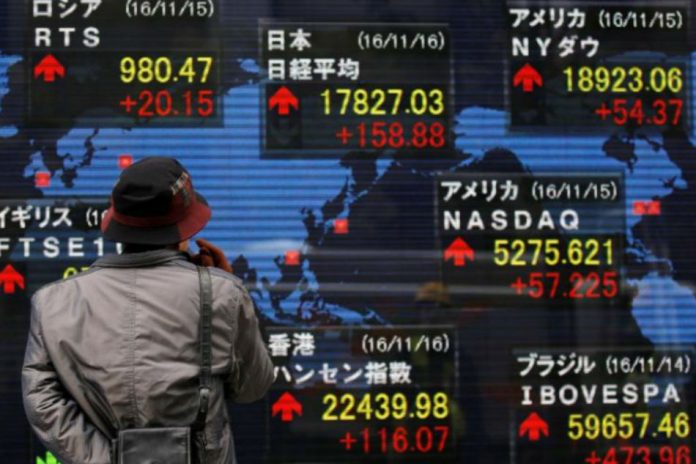SYDNEY: Asian share markets dithered on Friday as investors waited for concrete signs of progress in the U.S.-Mexican trade standoff, while bracing for a U.S. jobs report that could sway the course of interest rates there.
MSCI’s broadest index of Asia-Pacific shares outside Japan edged 0.04% higher and looked set for another cautious session being up just 0.6% for the week so far.
Japan’s Nikkei firmed 0.3%, but South Korea slipped 0.5%. E-Mini futures for the S&P 500 were mostly flat.
Mexican and U.S. officials had held a second day of talks on trade and migration on Thursday amid reports President Donald Trump might delay the imposition of tariffs that was due on Monday.
That had helped the Dow end Thursday up 0.71%, while the S&P 500 gained 0.61% and the Nasdaq 0.53%.
However, the White House later said the tariffs would go ahead as scheduled, and there were reports Trump might declare a national emergency to dodge any Senate objections.
The uncertainty kept investors from getting too bullish, particularly with the U.S. payrolls report promising to be an unknown quantity later in the session.
Market forecasts are for jobs to rise a solid 185,000 in May and unemployment to stay at a low 3.6%, though much was in doubt after dismal data on private hiring released earlier in the week.
“We haven’t adjusted our projection of 185,000 for overall nonfarm payrolls in May,” said Kevin Cummins, senior U.S. economist at RBS.
“However, any major surprises in May payrolls seem tilted to the low side of our forecast, which wouldn’t be too surprising given the rising uncertainty in the outlook in the U.S. and the above-trend gain registered in April.”
Oddly, a weak number might actually prove positive for equities since it would bolster the case for an early rate cut from the Federal Reserve.
Markets have fully priced in a cut by September, and a further two easings by mid-2020.
Two-year Treasury yields were near their lowest since December 2017 at 1.88%, having fallen 28 basis points in just two weeks.
KILLER PUNCH
That seismic shift in Fed expectations has hampered the U.S. dollar, which was currently down 0.7% for the week so far against a basket of currencies at 97.020.
The dollar has at least steadied on the yen at 108.44 and was off the recent five-month low of 107.80.
It fared less well on the euro which was currently holding gains of almost 1% for the week at $1.1273.
The single currency bounced sharply overnight after the European Central Bank pushed back the timing of any rate hike, but failed to canvass the policy easing that many had wagered on.
Money market futures are now pricing in a 45% chance of a 10 basis point euro zone rate cut by the end of year versus 75% before the ECB statement.
“The killer punch came at the press conference with President Draghi disappointing market’s dovish policy pricing with a series ‘optimistic’ remarks,” noted Rodrigo Catril, a senior FX strategist at NAB.
“The risk is that once the ECB realizes things are really bad, it will find itself well behind the curve.”
In commodity markets, all the chatter of rate cuts globally kept gold near 15-week highs at $1,333.45 per ounce.
Oil prices regained a little ground after a rough week but was still vulnerable to worries about global demand and oversupply.
Brent crude futures bounced 59 cents to $62.26, but were still down 3.5% for the week so far, while U.S. crude firmed 58 cents at $53.17 a barrel.
























